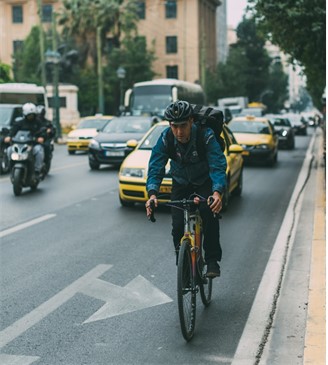Dr. Gabriel Hernandez Roman is a passionate cyclist who uses biking as his primary mode of transportation. Despite a hectic professional life, he finds time to pedal through city streets, a choice that not only saves him from traffic jams but also keeps him fit and energized. In the following article, Dr. Hernandez Roman delves into the factors behind the surge in urban cycling, exploring how it’s transforming cities and enriching the lives of residents. He also highlights the benefits of this growing trend, from reducing carbon emissions to promoting healthier lifestyles, and examines the challenges that urban cyclists continue to face, such as safety and infrastructure issues.
In recent years, urban cycling has seen a significant resurgence in major cities across the United States. As people seek alternative modes of transportation that are both eco-friendly and efficient, bicycles are becoming a popular choice for commuting and recreation. The growth of cycling infrastructure, along with cultural shifts towards healthier lifestyles, has played a key role in this trend.
Dr. Gabriel Hernandez Roman on the Factors Driving the Rise of Urban Cycling
A variety of factors have contributed to the growing popularity of cycling in urban environments, such as:
- Environmental Concerns: As awareness of climate change and environmental issues grows, many people are seeking alternatives to cars and public transportation. Bicycles are an eco-friendly mode of transportation that produce zero emissions and require no fuel. This shift aligns with broader efforts to reduce carbon footprints and promote sustainability.
- Health and Fitness: Gabriel Hernandez Roman says that cycling is an excellent form of exercise, offering cardiovascular benefits, improved muscle tone, and stress relief. As more people focus on health and wellness, cycling has become an attractive option for commuting and leisure. It’s a way to incorporate physical activity into daily routines without the need for a gym membership.
- Traffic Congestion: Urban areas are often plagued by traffic congestion, leading to longer commute times and increased stress for drivers. Bicycles offer a way to bypass traffic and navigate through cities more quickly and efficiently. Many commuters find that cycling can be faster than driving or taking public transportation during peak hours.
- Cost Savings: The rising cost of gasoline and vehicle maintenance has prompted many people to look for cost-effective transportation alternatives. Bicycles are significantly cheaper to maintain than cars, and they eliminate the need for parking fees and public transportation costs.
- Government Support: Many cities have recognized the benefits of cycling and have begun investing in infrastructure to support cyclists. Dedicated bike lanes, bike-sharing programs, and cycling-friendly policies have made it easier and safer for people to choose bicycles for their daily commutes.
Benefits of Urban Cycling
Dr. Gabriel Hernandez Roman says that the rise of urban cycling offers numerous benefits for individuals and cities as a whole:
- Reduced Environmental Impact: Cycling significantly reduces air pollution and carbon emissions compared to motor vehicles. This reduction in pollutants contributes to cleaner air and a healthier urban environment.
- Improved Public Health: Regular biking helps reduce obesity rates, heart disease, and other health issues. As more people incorporate cycling into their daily routines, the overall health of the community improves.
- Enhanced Mobility: Bicycles can navigate through congested traffic, reducing commute times and providing greater flexibility. Gabriel Hernandez Roman explains that this enhanced mobility can lead to a better quality of life for urban residents.
- Community and Social Connection: Urban cycling can foster a sense of community among cyclists. Bike-friendly cities often have vibrant cycling cultures, with events, groups, and clubs that bring people together.
- Reduced Traffic Congestion: As more people opt for bicycles, the strain on urban traffic infrastructure is reduced. This can lead to smoother traffic flow and less frustration for drivers and commuters.

Challenges and Solutions
Despite the many benefits, it also faces several challenges that need to be addressed for it to reach its full potential:
- Safety Concerns: Safety is a major concern for urban cyclists. Accidents involving bicycles and motor vehicles can be severe, leading to injuries and fatalities. To address this issue, cities need to invest in dedicated bike lanes, clear signage, and traffic-calming measures to improve safety for cyclists.
- Infrastructure Limitations: While many cities have made progress in developing cycling infrastructure, there is still a long way to go. Cities must continue to expand bike lanes, provide secure bike parking, and create safe intersections for cyclists.
- Cultural Shifts: Dr. Gabriel Hernandez Roman notes that in some areas, cycling is still not seen as a mainstream mode of transportation. Overcoming cultural biases and promoting cycling as a legitimate and respected form of commuting requires ongoing education and advocacy.
- Weather and Climate: Biking can be influenced by weather conditions, with rain, snow, and extreme temperatures posing challenges. Cities can help by providing covered bike parking and encouraging cycling-friendly clothing and gear.
Conclusion
The rise of urban cycling in major US cities is a positive trend that offers numerous benefits to individuals and the environment. Gabriel Hernandez Roman highlights that with a focus on sustainability, health, and improved mobility, urban cycling has the potential to transform the way people navigate cities. By addressing safety concerns, investing in infrastructure, and fostering a supportive cycling culture, cities can continue to promote and expand urban cycling, creating healthier, more connected, and more sustainable urban environments.









